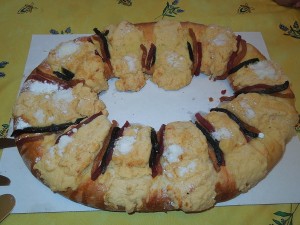This year, a friend who grew up in Mexico and lives in San Diego invited us to her family’s annual Rosca de Reyes party on January 6. The celebration always falls 12 days after Christmas, and marks the Christian Feast of the Epiphany, when the Three Wise Men or Magi–los Reyes Magos–arrived bearing gifts for the newborn baby Jesus.
“Rosca” means “ring” and “reyes” means “kings.” Rosca de Reyes refers to the special sweet “Kings Bread” that is baked for the occasion. Round or oval in shape to recall a King’s crown, the bread contains a tiny figure of the baby Jesus, baked inside to commemorate the Holy Family’s furtive flight to Egypt to escape Herod’s edict to kill all baby boys, lest one be the prophesied Messiah.
Part of the tradition is that whoever gets the piece of cake with the baby Jesus baked inside must host a party on February 2, the Feast of the Candelaria, and serve tamales to the guests. That person happened to be my eight-year-old son Mateo, who was delighted at the prospect.
I grew up in a fairly traditional Catholic family—Mass every Sunday beginning at the age of three; twelve years of Catholic school taught by nuns—yet I’d never celebrated Epiphany (as we always called it) or Three Kings Day in any way beside going to Mass. But I learned that in Spain and Latin America, for many families, Three Kings Day is the “main day,” bigger than Christmas, the day when children awake to find gifts left by the Kings inside or near their shoes. You can learn more from this Wikipedia entry.
Interestingly, I was discussing our Rosca de Reyes party with another friend, this one from the Bay Area, who happened to be traveling in the American South during the holidays. She reported seeing Rosca de Reyes bread decorated in purple, gold, and green, the traditional Mardi Gras colors, and observed that the tradition somehow had gotten folded into Shrove Tuesday celebrations. Another friend from the Bay Area told me that every January 6, her husband, born in Mexico, dressed up as one of the Wise Men (Melchior) to participate in a pageant enacted at their church.
How have I lived so long and never before experienced this holiday in this way? One of many questions I ask myself.
The photo above shows the Rosca de Reyes we ate this year, which was delicious. As for Mateo hosting the February 2 party: The last weekend in January we’re attending the large annual gathering of our local adoptive families with children from Guatemala, and I’m telling myself that the date is close enough to February 2 to count. Just to be sure, we’ll bring tamales.
Meanwhile, I’m very grateful to my friend for including us in her family’s Rosca de Reyes celebration, and especially for introducing my children to this Latin American tradition.
P.S.:
Click on the link to find a recipe for Rosca de Reyes from the website Mexico in My Kitchen and another from Adoptive Families magazine.




 ShareThis
ShareThis
My first experience with this holdiay was in 2012, when I went to a local Mexican bakery and there were 3 Kings in full costume, in a small shed, passing out toys to a very long line of children. The children were visiting with the Kings and each received a small gift. The families were also buying the traditional cakes, which were very pretty and filled with a cream cheese filling. They were a yeast based bread, and really not sweet.
The King Cake” at Mardi Gras season is a yeast based cake, but is sweeter than this was. It is sprinkled with sugar or covered in icing that is the colors of Mardi Gras. Both of these have the baby figure baked inside, or hidden under the cake. In our part of TEXAS we see lots of King Cakes in the grocery stores this time of year, but I had never seen the Rosca de Reyes cake until last year. Only after happeing up on this celebration, did I remember a tour guide in Guatemala telling us about this, as part of the discussion concerning te Guatemalan Christmas celerations.
Jerry, thank you so much for sharing these stories. Fascinating! I love the image of the Three Kings in full regalia, passing out toys. My friend who dressed as Melchior described something similar: Kids lined up at church to take photos with him and the other Kings. Next year, I will seek out this particular element of the festivity.
We spent one Christmas in Guatemala–2002–and the holiday made a big impression. It was so uncommercial! In Antigua, for several nights, we watched beautiful processions through town that re-enacted the Nativity, and public outdoor concerts by the National symphony and other local musical groups. Memorable. And I clearly remember Olivia having no idea who Santa Claus was the year after we got home. She had never seen his likeness anywhere in Guatemala.
Now that I look back, we may have flown home on January 6, which is why I missed the Rosca de Reyes cake there. Glad I know about it now.
Thank you again for sharing your insights. ~
After posting my response, I realized that we spent Christmas 2003 in Antigua, not 2002. (Not that it matters to anyone except me!) We came home in January 2004. Just to be accurate. 🙂